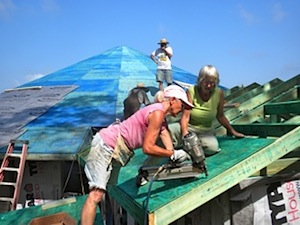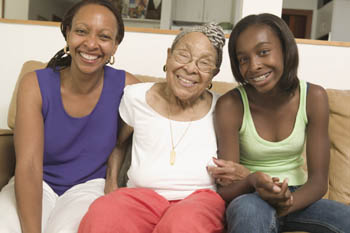How Social Connections Keep Seniors Healthy
As we age, we tend to shed family and friends—which can hurt our mental and physical health. How can we design communities for seniors that facilitate social connections?
.jpg)
Vonda is an energetic 73-year-old woman with a friendly smile and a sharp wit. For the last two decades she’s been living in an intentional farming community called “Potluck Farm” with other individuals and families on 170 acres in rural North Carolina.
Vonda Frantz (foreground, in pink shirt) putting the roof on the common house for Potluck Farm's new Elderberry community.
But recently, she realized something: She’s getting older. Though she loves the farm, living far apart on separate 6-acre parcels means that neighbors don’t see each other that often and can’t easily help each other in a pinch. Caring for the large piece of property is getting tougher, too.
So she and some friends have begun building a new community—smaller and adjacent to the old—where houses will be built closer together, more activities will be shared, and neighbors will grow food and maintain their lifestyle, while caring for one another.
“The most important thing in a community like this is having people around to support and engage you,” says Vonda. “Taking care of each other keeps you alive and healthy.”
It turns out that Vonda and her friends are on to something. Researchers have long known about the health benefits of “social capital”—the ties that build trust, connection, and participation. But this link may be particularly important for seniors, precisely because both our health and our social capital tend to decline as we age. We retire from jobs, lose friends and spouses to death and illness, and see family members move out of the area—all of which can sharply reduce daily social contacts and stimulation, which in turn has a direct impact on mental and physical health.
Fortunately, there are solutions: More and more studies are discovering how senior communities can be designed to maximize sharing, friendship, health, and happiness in our later years.
Social capital for seniors
Yvonne Michael, an epidemiologist from the Drexel University School of Public Health, studies the effects of social capital on seniors. To measure community social capital, thousands of individuals living in different neighborhood are asked to respond to questions like, “Are your neighbors willing to help each other with routine maintenance?” or, “Can you trust your neighbors?” From these answers, Michael can gauge the connections between health, behavior, and social capital.
In one study, Michael analyzed data from a large health survey of nearly 14,000 adults in Southeastern Pennsylvania. After measuring the levels of mobility among the seniors living in those neighborhoods, Michael found that those living in areas with greater social capital had significantly higher physical mobility scores than those living in lower social capital neighborhoods.
“These results are not too surprising,” says Michael. “Living in a place with greater social capital—where there is more trust and more helpful neighbors—you will feel more comfortable walking around to get to places you need to go, which helps you stay mobile.”
In another study, Michael looked at how social capital related to positive health-seeking behavior—specifically getting recommended cancer screenings. Although this study was not focused only on the elderly, she found that in neighborhoods with higher levels of social capital, adults were 10-22 percent more likely to get screened at the recommended ages, suggesting earlier diagnoses and treatment for serious diseases.
“People who live in neighborhoods high in social capital have better health information diffusion and enforcement of norms,” says Michael. “When the norms are healthy—like getting health screenings, not smoking, or walking around the neighborhood—they will be enforced throughout the population.”
A community with higher social capital may also be able to offer more assistance to seniors who need help with routine maintenance tasks, she says. For example, if you are elderly and you need to replace shingles on your roof or you need to shovel snow off your walk, it’s more likely you’ll find a helpful hand in a neighborhood high in social capital.
“In that kind of place, there’s a level of connection that allows older people to age in place,” she adds.
How social connections save lives
Higher levels of social interaction—even peripheral interactions—can have a high payoff for elderly folks, says Bryan James, an epidemiologist at the Rush Alzheimer’s Disease Center in Chicago. Although he doesn’t study social capital the way Michael does—as an overall community trait—James does study the impact of greater social activity levels in individuals and its impact on health.
In one study, James looked at how social activity affected cognitive decline. Over 1100 seniors without dementia at baseline were measured on their social activity levels and then tested periodically on their cognitive functioning over a 12-year period. The rate of cognitive decline was 70 percent less in people with frequent social contact than those with low social activity.
“When you use your brain and body the way it was intended—as it evolved—you age better,” says James. “We just aren’t meant to be disengaged from one another.”
In another study, James looked at a community-based cohort of older people free of dementia and measured social activity levels and their disability levels—in terms of their ability to care for themselves. Findings showed that those with more frequent social activity maintained lower levels of disability in several areas, suggesting that they would be able to live independently longer than their less social counterparts.
“The predominant theory is use it or lose it, “ says James. “Social activity is related to motor function, just like physical exercise is related. We can’t determine which is most important—they each contribute a piece of the puzzle.”
His results are truly dramatic. Even when he and his colleagues statistically control for risk factors like smoking or a history of disease, they still find that someone with high levels of social activity has 43 percent less disability than someone who has low levels of social activity, and about half the rate of cognitive decline.
Communities high in social capital offer a lot to seniors, because they can augment opportunities for seniors to have those kinds of social connections. “If you are in a more cohesive neighborhood, you will more likely engage with others in your neighborhood,” says Michael, and that can bring great benefits socially and otherwise.
Designing neighborhoods for social capital
But not all people benefit from social capital in the same way, says researcher Spencer Moore at Queen’s University in Ontario.
According to Moore, some seniors don’t benefit as much from having high social capital in their communities, in part because they have strong social networks outside of their neighborhoods and ready access to them, which make neighborhood support less central. Also, low-income seniors tend to live in communities that are more homogenous and don’t provide as many opportunities for stimulation or for diverse social ties, which are both important for health.
“We really need to foster public policies that will support programs that create opportunities for low-income elderly to get outside of their neighborhoods, to have more diverse connections,” says Moore.
Despite the proposed benefits of social capital, though, many communities lack those things that foster better connection, like public places to gather or opportunities to engage in meaningful work. Or worse, they suffer from high crime rates. A senior who finds no welcoming place in the community may end up alone at home watching TV most days. And that can spell disaster for their physical and emotional health.
So what can one do to increase social capital? Creating a community like Vonda’s is ideal; but many elderly can’t afford to move, nor would they necessarily want to. Still, some are taking notice of the findings from social capital research to do what they can to make their communities cater more to seniors.
For example, one organization, Vital Aging Network (VAN), located in Minnesota, is helping seniors to become social change agents in their communities. VAN trains seniors in community organizing, giving them the skills to assess what their neighborhood needs, gather resources, and start new programs. Projects initiated through VAN training have included things like creating walking paths for seniors, bringing a “balance exercise program” to a community to decrease falls among seniors, and initiating a program to befriend isolated seniors, among many others.
“Often seniors are seen as people who need services instead of people who have a lot to offer,” says Julie Roles, a program director at VAN. “We focus on community-based development, where seniors have the freedom to determine what they need and how to get it.”
Helping seniors to stay engaged with their community and to continue to make positive contributions, according to James, is invaluable. The health benefits of volunteerism are well documented, including its impact on increasing longevity, he says—but it’s even more powerful when your efforts give you a sense of purpose in life.
“People who have the strongest sense of purpose are much less likely to become depressed, have neuroticism, or get Alzheimer’s,” says James.
Vonda feels the same way. Her community has plans to keep themselves connected socially and actively involved with each other’s welfare, while still maintaining ties to their surrounding community. They will have a central community space open to other groups to use, and will be inviting seniors to teach each other new skills—like gardening or blacksmithing—that are useful to farm living.
“We plan to have people doing real work, instead of being taken to the mall or asking them to engage in invented, frivolous time-occupiers,” says Vonda.
She believes that physical exercise, coupled with deep social connections and a commitment to taking care of one another, will keep members of her community healthier and prevent their needing to move into some other, less interactive environment, like a nursing home. She and her friends are adamant about doing all they can to age not just gracefully, but with vitality.
“I kind of refuse to grow old,” she says.
This article is printed here with permission from the Greater Good Science Center (GGSC). Based at UC Berkeley, the GGSC studies the psychology, sociology, and neuroscience of well-being, and teaches skills that foster a thriving, resilient, and compassionate society. The author of this article, Jill Suttie, Psy.D., is Greater Good‘s book review editor and a frequent contributor to the magazine.





On May 10, 2014 Donna Thomson wrote:
This is a wonderful article, thank you! I just wanted to add that there are a number of internet platforms that help to coordinate the face to face support and social interaction of seniors (and others vulnerable to the effects of social isolation). TYZE is one - it's free (www.tyze.com) and unlike other similar platforms, it's completely secure and password encoded. Also, it allows paid caregivers to coordinate with family/friends, if that needs to happen. We use Tyze for Mom who is 92 and her life is much better for it.
Post Your Reply